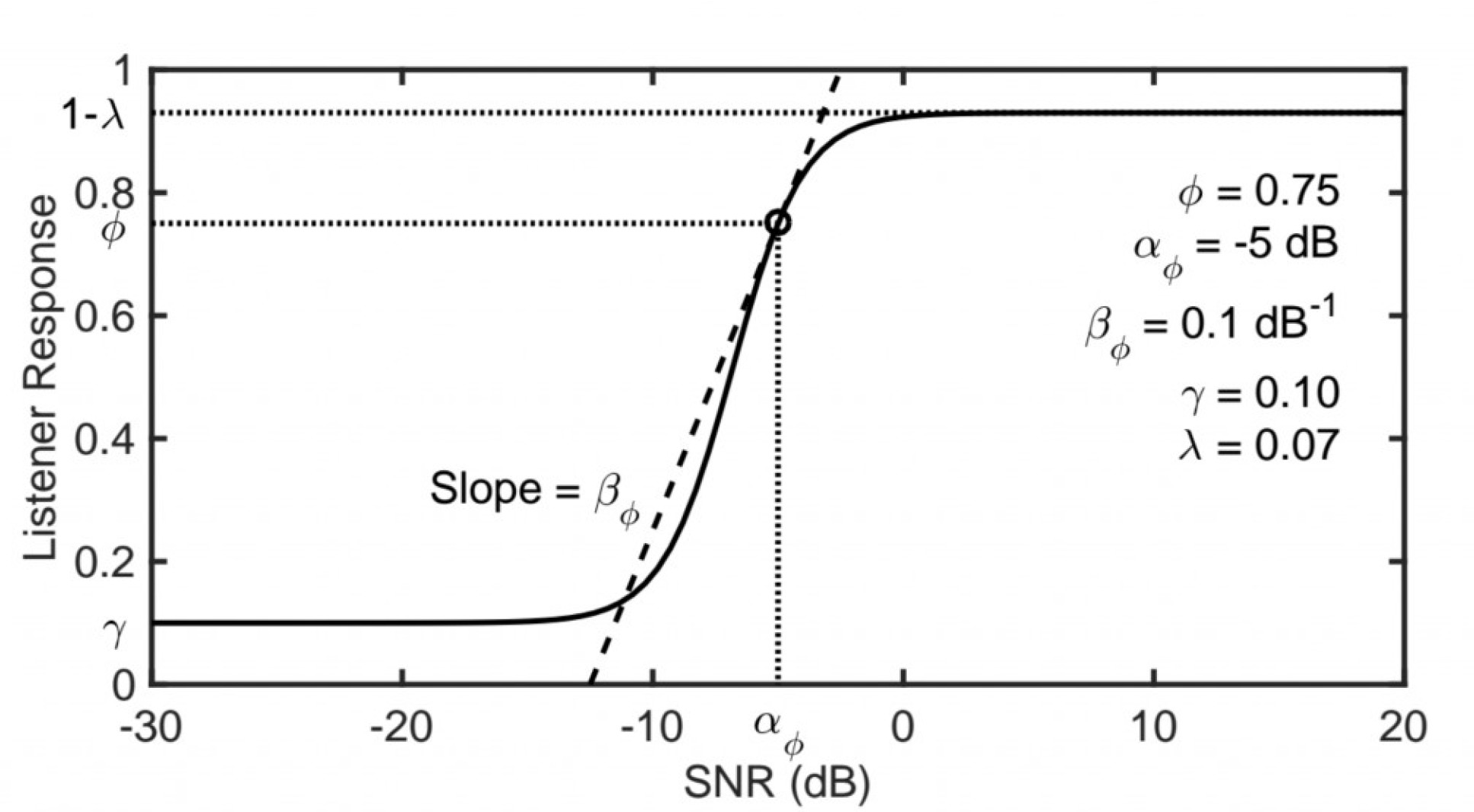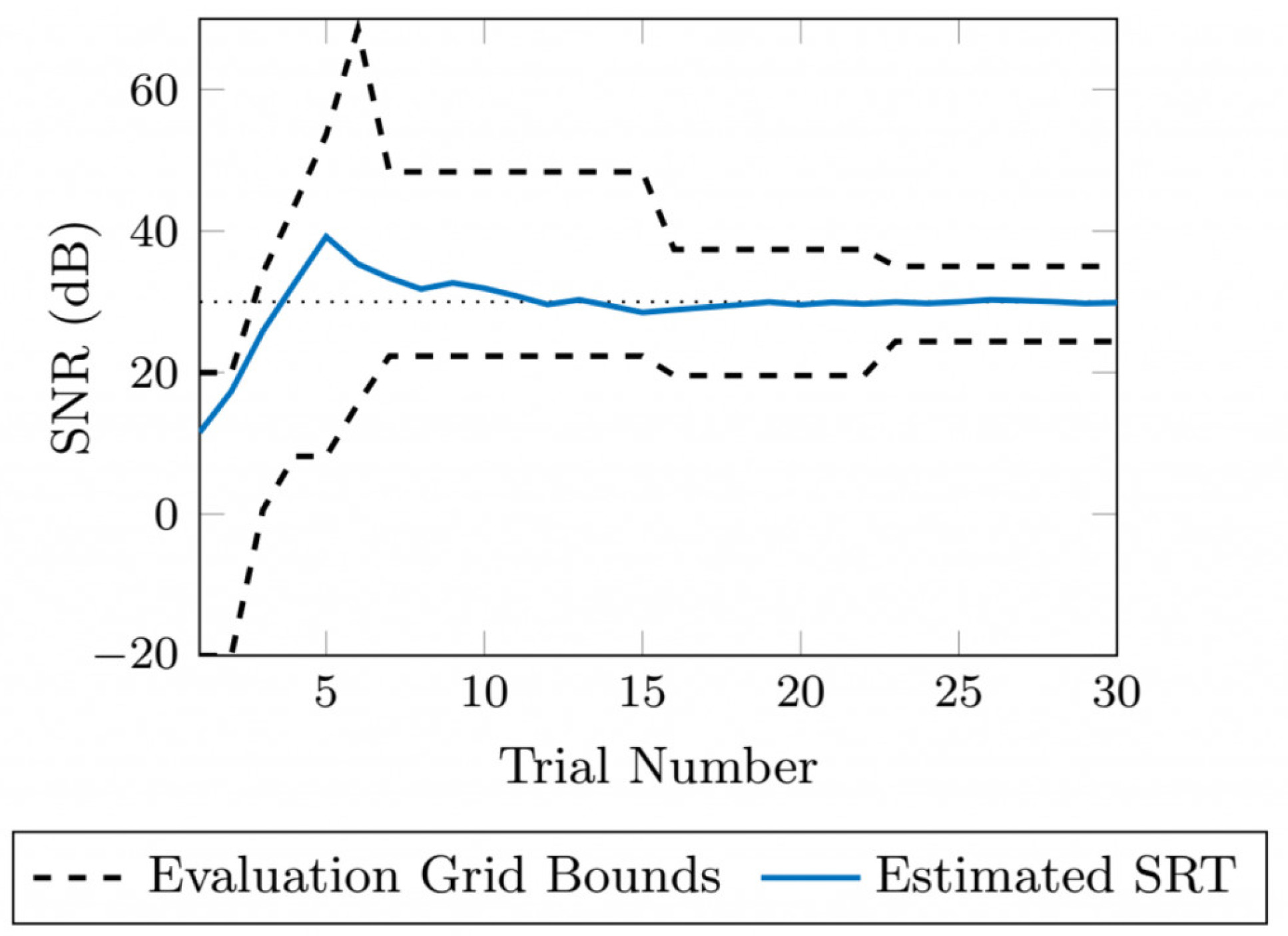Psychometric function estimation
Robust and efficient Bayesian adaptive psychometric function estimation
In the context of speech intelligibility measurement, the psychometric function (PF) links signal-to-noise ratio (SNR) and the probability of correctly understanding a speech utterance. Efficient procedures for estimating the SNR at 50% intelligibility score are well documented, however when one wants to evaluate both this Speech Reception Threshold (SRT) and the slope of the PF at this SNR, the list of available accurate methods is significantly smaller.
The present research provides a Bayesian method for addressing both accuracy and efficiency of the PF estimation problem while being robust to erroneous prior assumptions. It extends the work of [1] and [2] and addresses two independent issues: the sequence of probe SNRs that should be used in order to maximize the efficiency and accuracy of the estimation procedure, and the method of estimating the SRT and slope from the observations.
The procedure differs from previously proposed algorithms in two respects: (i) it does not require the range of possible psychometric function parameters to be specified in advance and (ii) the sequence of probe SNRs optimizes the threshold and slope estimates at a performance level, Φ, that can be chosen by the experimenter.
 The estimation of the PF parameters is performed by computing the mean of their joint posterior distribution, discretized over the parameter space and thus approximated by a two-dimensional evaluation grid. In order to make the method more computationally efficient and remove the need for prior knowledge of the possible range of PF parameters, an adaptive rescaling and resampling scheme of the evaluation grid is performed after each trial. It allows us to keep the number of discretized values to a minimum because the grid contracts around the mean of the posterior distribution as convergence progresses. Also, if the mean of the distribution gets too close to one of the bounds of the discretized space, the grid will automatically expand to accommodate for this, thus removing the need to specify the range of possible parameter values in advance. This is illustrated in the figure below.
The estimation of the PF parameters is performed by computing the mean of their joint posterior distribution, discretized over the parameter space and thus approximated by a two-dimensional evaluation grid. In order to make the method more computationally efficient and remove the need for prior knowledge of the possible range of PF parameters, an adaptive rescaling and resampling scheme of the evaluation grid is performed after each trial. It allows us to keep the number of discretized values to a minimum because the grid contracts around the mean of the posterior distribution as convergence progresses. Also, if the mean of the distribution gets too close to one of the bounds of the discretized space, the grid will automatically expand to accommodate for this, thus removing the need to specify the range of possible parameter values in advance. This is illustrated in the figure below.

To obtain a reliable estimate of the PF parameters with as few trials as possible, the SNR at which to probe at the next trial must be chosen carefully so as to optimize the efficiency. In the proposed method, we investigate the next probe SNR selection based on the minimization of the expected cost after either one or two predicted observations.
Our proposed procedure is robust to variations in the listener PF and, over a wide range of listener PF parameters, the RMS errors were 1.2 dB in SRT and 0.14 in log-slope for a 50-trial measurement. It was found that the performance differences between the look 1-ahead and look 2-ahead methods were negligible and that an entropy-based criterion for selecting the next stimulus was preferred to a variance-based criterion.
Results from this project are presented in [3]. An implementation in MATLAB of the proposed method is available as psycest.m in the VOICEBOX toolbox. For access to the experimental data in [3], please click here.
References
[1] L. L. Kontsevich, C. W. Tyler. Bayesian adaptive estimation of psychometric slope and threshold. In Vision Research 39, 2729–2737, 1999.
[2] N. D. Gaubitch, D. M. Brookes, P. A. Naylor, D. Sharma. Bayesian adaptive method for estimating speech intelligibility in noise. In Proc. AES 39th Int. Conf. on Audio Forensics, 169–174, 2010.
[3] C. S. J. Doire, D. M. Brookes, P. A. Naylor. Robust and efficient Bayesian adaptive psychometric function estimation. Journal of the Acoustical Society of America, vol. 141 (4), 2501-2512, Apr. 2017. DOI: 10.1121/1.4979580


